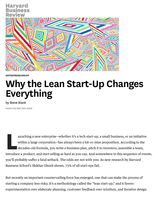Why the Lean Start-Up Changes
Everything
by Steve Blank
FROM THE MAY 2013 ISSUE
L
aunching a new enterprisewhether it’s a tech start-up, a small business, or an initiative
within a large corporationhas always been a hit-or-miss proposition. According to the
decades-old formula, you write a business plan, pitch it to investors, assemble a team,
introduce a product, and start selling as hard as you can. And somewhere in this sequence of events,
you’ll probably suer a fatal setback. The odds are not with you: As new research by Harvard
Business School’s Shikhar Ghosh shows, 75% of all start-ups fail.
But recently an important countervailing force has emerged, one that can make the process of
starting a company less risky. It’s a methodology called the “lean start-up,” and it favors
experimentation over elaborate planning, customer feedback over intuition, and iterative design
over traditional “big design up front” development. Although the methodology is just a few years
old, its conceptssuch as “minimum viable product” and “pivoting”have quickly taken root in the
start-up world, and business schools have already begun adapting their curricula to teach them.
The lean start-up movement hasn’t gone totally mainstream, however, and we have yet to feel its
full impact. In many ways it is roughly where the big data movement was ve years agoconsisting
mainly of a buzzword that’s not yet widely understood, whose implications companies are just
beginning to grasp. But as its practices spread, they’re turning the conventional wisdom about
entrepreneurship on its head. New ventures of all kinds are attempting to improve their chances of
success by following its principles of failing fast and continually learning. And despite the
methodology’s name, in the long term some of its biggest payos may be gained by the large
companies that embrace it.
In this article I’ll oer a brief overview of lean start-up techniques and how they’ve evolved. Most
important, I’ll explain how, in combination with other business trends, they could ignite a new
entrepreneurial economy.
The Fallacy of the Perfect Business Plan
According to conventional wisdom, the rst thing every founder must do is create a business plana
static document that describes the size of an opportunity, the problem to be solved, and the solution
that the new venture will provide. Typically it includes a ve-year forecast for income, prots, and
cash ow. A business plan is essentially a research exercise written in isolation at a desk before an
entrepreneur has even begun to build a product. The assumption is that it’s possible to gure out
most of the unknowns of a business in advance, before you raise money and actually execute the
idea.
Once an entrepreneur with a convincing business plan obtains money from investors, he or she
begins developing the product in a similarly insular fashion. Developers invest thousands of man-
hours to get it ready for launch, with little if any customer input. Only after building and launching
the product does the venture get substantial feedback from customerswhen the sales force
attempts to sell it. And too often, after months or even years of development, entrepreneurs learn
the hard way that customers do not need or want most of the product’s features.
Sketch Out Your Hypotheses
The business model canvas lets you look
at all nine building blocks of your business
on one page. Each component of the
business model contains a series of
hypotheses that you need to test.
Find this and other HBR graphics in our VISUAL
LIBRARY
SOURCE: WWW.BUSINESSMODELGENERATION.COM/CANVAS. CANVAS
CONCEPT DEVELOPED BY ALEXANDER OSTERWALDER AND YVES
After decades of watching thousands of start-ups follow this standard regimen, we’ve now learned
at least three things:
1. Business plans rarely survive rst contact with customers. As the boxer Mike Tyson once said
about his opponents’ preght strategies: “Everybody has a plan until they get punched in the
mouth.”
2. No one besides venture capitalists and the late Soviet Union requires ve-year plans to forecast
complete unknowns. These plans are generally ction, and dreaming them up is almost always a
waste of time.
3. Start-ups are not smaller versions of large
companies. They do not unfold in accordance
with master plans. The ones that ultimately
succeed go quickly from failure to failure, all the
while adapting, iterating on, and improving their
initial ideas as they continually learn from
customers.
One of the critical dierences is that while
existing companies execute a business model,
start-ups look for one. This distinction is at the
heart of the lean start-up approach. It shapes the
lean denition of a start-up: a temporary
organization designed to search for a repeatable
and scalable business model.
The lean method has three key principles:















 분야
분야


